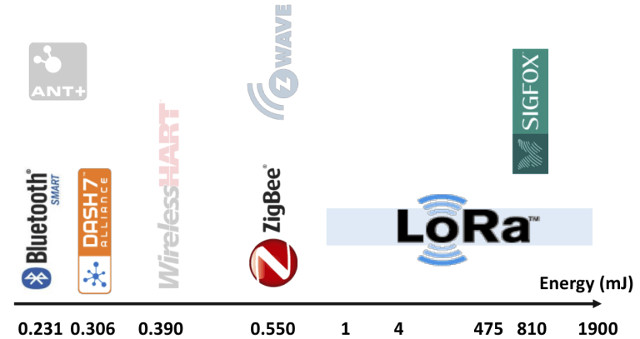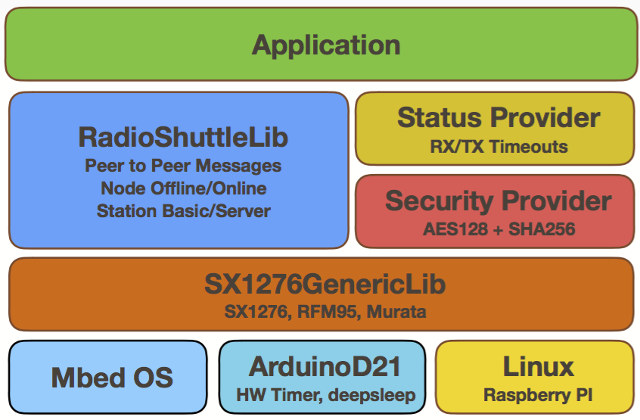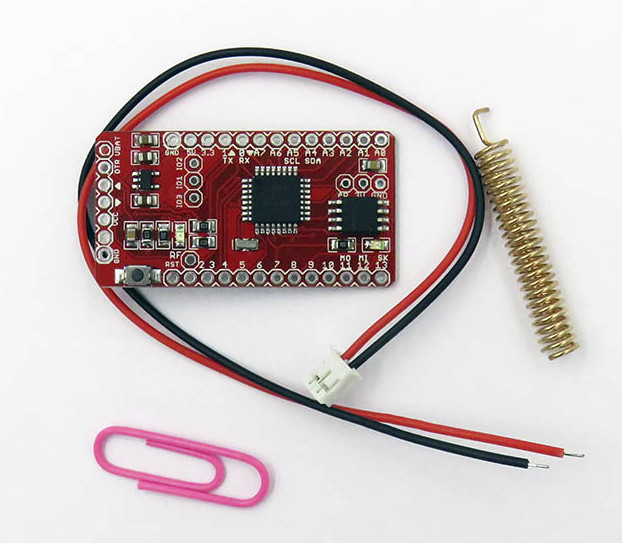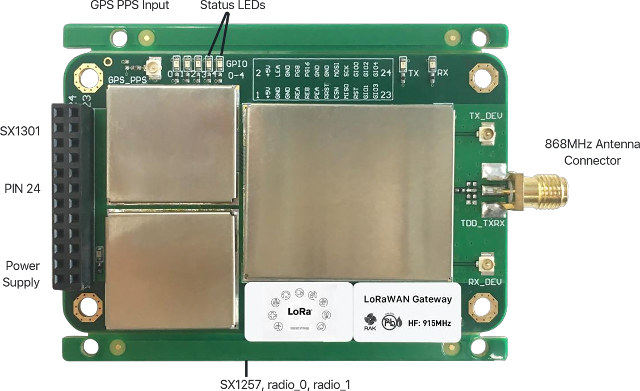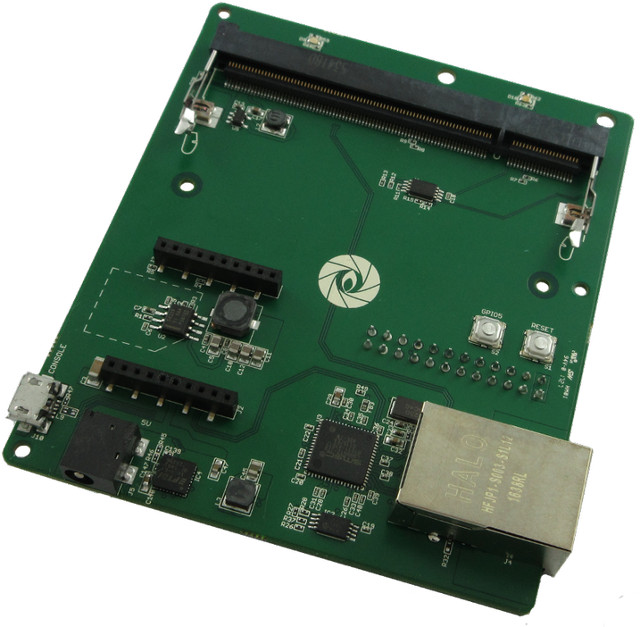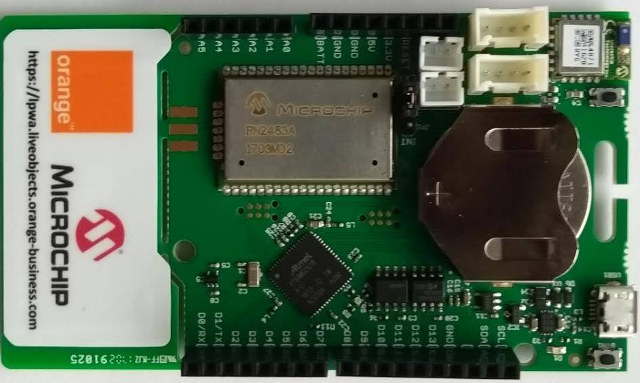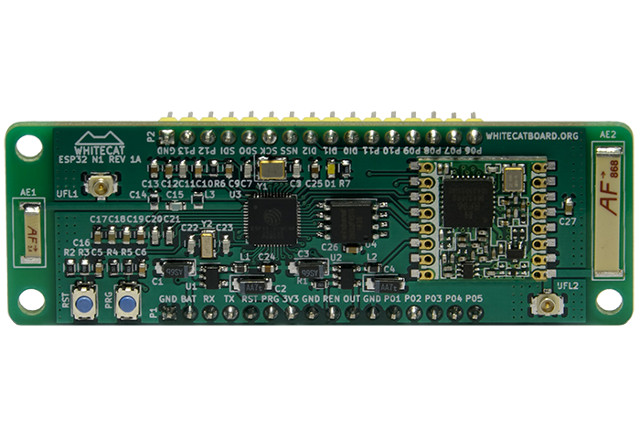Over the last few years, I’ve written several article about LoRaWAN, Cellular IoT, and Sigfox based long range low power IoT solutions. DASH7 is another LPWAN (Low Power Wide Area Network) standard that operates on the same 868 and 915 MHz ISM bands as LoRa and Sigfox, but has much lower power consumption, and the cost of a shorter range up to 500 meters, instead of the 5+km associated with LoRa or SigFox. The DASH7 Alliance Protocol (D7A) is an Open Standard, and if you want more details you can download version 1.1 of the specifications on DASH7 Alliance website. I’m writing about DASH7 today thanks to an article on ST blog about Wizzilab’s Wizzikit, an evaluation kit and framework for DASH7 with a gateway, and several nodes that can also optionally support LoRaWAN and Sigfox protocols. The kit is comprised of the following items: WizziGate GW2120 Ethernet/Wifi/Dash7 gateway – based […]
RadioShuttle Network Protocol is an Efficient, Fast & Secure Alternative to LoRaWAN Protocol
LoRaWAN protocol is one of the most popular LPWAN standards used for the Internet of Things today, but some people found it “lacked efficiency, did not support direct node-to-node communication, and was too costly and far too complicated for many applications”, so they developed their own LoRa wireless protocol software called RadioShuttle, which they claim is “capable of efficiently sending messages in a fast and secure way between simple LoRa modules”. Some of the key features of the protocol include: Support for secure or insecure (less time/energy) message transmission, multiple messages transmission in parallel Unique 32-bit device ID (device number) per LoRa member, unique 16-bit app ID (program number for the communication) Security – Login with SHA-256 encrypt password; AES-128 message encryption Air Traffic Control – Nodes only send if no LoRa signal is active on that channel. Optimized protocol – Message delivery within 110 ms (SF7, 125 kHz, free […]
$6.10 Loraduino Board Combines LoRa and Atmega328P MCU
We’ve previoulsy seen low costs SX1278 LoRa modules @ 433 MHz which you could connect to your own board, but Electrodragon is now selling Loraduino board with an Atmega328P MCU and SX1278 for just $6.10 / 5 Euros plus shipping, and using a layout similar to Arduino Pro Mini. Loraduino specifications: MCU – Microchip / Atmel Atmega328P MCU with Arduino pro mini bootloader Storage – 16Mbit SPI flash for data LoRa Semtech SX1278 IC with 433mhz, or 470mhz central frequency 10 km max range 20dbm max power rate (configurable by software) Tx current: 120 mA @ + 20 dBm; 90mA @ + 17dBm; 29mA @ + 13dBm Data Rate – 1.2K to 300Kbps with FSK; 18 bps to 37.5Kbps with LoRa Expansion SX1278 Lora: leadout for pins IO1, IO2, IO3 Atmega: 14x digital input/output pins (including 6x PWM outputs), 6x analog inputs (TBC) Misc – Programmable LED (D7), power LED, […]
RakWireless RAK831 LoRa Gateway Module is Based on Semtech SX1301 Base Band Processor
We’ve previously covered several products from RakWireless, with a Realtek WiFi IoT board, a WiFi camera board, and a Amazon Alexa compatible audio board. The company has now launched RAK831, a LoRaWAN gateway board powered by Semtech SX1301 base band processor, and working with their RAK811 LoRa node or other compatible nodes. RAK831 LoRA gateway board specifications: Connectivity Semtech SX1301 base band processor with LoRa concentrator IP Frequency bands – 433, 470, 868, or 915 MHz Sensitivity – Down to -142.5 dBm Maximum link budget – 162 dB Output power level – up to 23 dBm Emulates 49 x LoRa demodulators 12x parallel demodulation paths 1x (G)FSK demodulator 2x SX1257 Tx/Rx front-ends high frequencies 2x SX1255 Tx/Rx front-ends low frequencies Range – Up to 15 km (Line of Sight); several kilometers in urban environment GNSS – Optional GPS support Host Interface – SPI Expansion – 24-pin 2.54mm pitch “DB24” header […]
Gumstix Pi Conduit Gateway Board Leverages Raspberry Pi Compute Module, Off-the-Shelf LoRa and Cellular Modules
Gumstix has designed Pi Conduit Gateway baseboard for both the Raspberry Pi Compute Module and RisingRF RHF0M301 LoRa gateway module, in order to create a Linux based LoRa gateway that can optionally support LTE or other cellular connectivity via NimbeLink Skywire cellular modem. Conduit Pi LoRa Gateway board specifications: 200-pin SO-DIMM connector for Raspberry Pi Compute Module / Raspberry Pi 3 Compute Module (CM3 / CM3L) Headers for RisingRF RHF0M301 LoRa Module NimbeLink Skywire 2G/3G/4G cellular modem connector Low profile 10/100M Ethernet jack (implemented via USB 2.0) USB – 1x micro USB port for debugging via an FTDI USB to TTL chip Misc – User (GPIO5) and reset buttons Power Supply – 5V via power barrel The board was designed using Geppetto, which means you should be able to customize it to your needs by modifying it the original design in a web browser, and order your brand new custom […]
Microchip based Orange LoRa Explorer Kit Connects to Orange’s own LoRaWAN Network
You’d think Telecom operators with all infrastructure in place would focus their IoT efforts on LTE Cat M1 or LTE Cat NB-IoT, but Orange has setup its own LoRa network in France with the aim of achieving national coverage by December 2017, at which time they’ll also test interconnection and roaming with other European operators. The company has also launched the LoRa Explorer Kit based on Microchip solutions, and designed by SODAQ. Orange LoRa Explorer Kit specifications: MCU – Microchip Atmel SAMD21 ARM Cortex M0+ MCU @ 48 MHz with 256KB flash, 32KB RAM, up to 16KB EEPROM by emulation Storage – 4Mbit serial flash (Microchip SST25PF040C) Connectivity Microchip RN2483A LoRa module + PCB antenna Microchip RN4871 Bluetooth 4.2 module (BLE) with ceramic antenna Security – Microchip ATECC508A1 crypto chip to securely store LoRa keys. USB – 1x micro USB port for charging and programming Expansion – “Arduino M0” compatible headers with 10-bit […]
8Power Vibration Energy Harvesting Technology Powers Batteryless LPWAN GPS Trackers, MEMS Sensors
While IoT products usually promises one to 10 years battery life, they will be several billions of them, and ARM’s CEO even forecast one trillion IoT devices in the next 20 years. Recharging batteries at home may be fine, but imagine having to recharge or replace batteries on top of electric poles, inside walls, in remote locations, and other hard to reach places, considerable resources would have to be deployed just to replace or recharge battery every year or whenever the battery is close to being depleted. That’s why work on energy harvesting technology for batteryless devices may be so important, and 8Power is one of the companies working in the field through their vibration energy harvesting technology that is said to harvest up to 10x the power of competing devices under comparable condition thanks to the use of parametric resonance phenomenon. The company has recently announced their Track 100 family […]
Whitecat ESP32 N1 Board Combines ESP32 WiFi + Bluetooth SoC with a LoRa Transceiver, Runs Lua RTOS
Espressif ESP32 SoC is gaining traction right now as prices have come down, and there’s still an on-going fight among LPWAN standards with LoRaWAN being fairly popular in Europe. Whitecat, a group of engineers from several companies based in Citilab, Barcelona, Spain, has designed a board that combines both ESP32 and a LoRA transceiver, bringing an alternative to Pycom LoPy board, but instead of running MicroPython, they have developed Lua-RTOS. Whitecat ESP32 N1 hardware specifications: SoC – Espressif ESP32 dual-core Tensilica LX6 microprocessor @ up to 240MHz with 520kB internal SRAM Storage – 4MB flash memory Connectivity LoRa WAN transceiver working in the 868 (EU) MHz / 915 (USA) MHz with on-board antenna, and u.FL connector for external antenna Integrated 802.11b/g/n WiFi transceiver with on-board antenna, and u.FL connector for external antenna Integrated dual-mode Bluetooth (classic and BLE) I/O Headers – 2x 16-pin with SPI, I2C, I2S, SDIO, UART, CAN, […]


